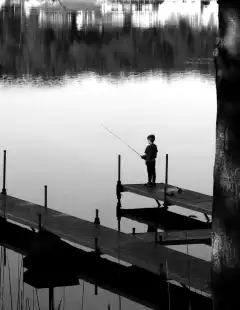By Kate Stockrahm
Pierce Park is preparing for a major transformation in late summer, including introducing wetlands, meadows, reforestation, and accessibility paths to the 67-acre former golf course.
Bounded by Interstate-69, Dort Highway, Gilkey Creek, and residences on the south side of Flint’s College Cultural neighborhood, the park has lived a host of lives since it was donated to the City of Flint by the Pierce family in the 1940s.
“It’s got a restricted deed,” explained Pierce Park Nature Preserve (PPNP) president Mike Keeler on a sunny afternoon walk around the park. “It says it will remain in the city’s property as long as it remains for recreation.”
Keeler said he believed Flint administrators decided to turn the site into an 18-hole golf course in the 1960s.
“At one point in time before the oil embargo, which was the mid-70s, this park used to be lit during the summer, and you could play golf all night long if you really wanted to,” Keeler said, smiling.
He noted that the site was also a former location for Flint Junior Golf, and many area residents recall the park as where they learned to play.
“This became a senior center, too,” Keeler added, pointing to a now-vacant plot that used to sport the golf course’s clubhouse. The building burned in September 2020, though it had already been shuttered in 2012 during Flint’s emergency management.

The remnants of Pierce Park’s former golf course clubhouse building in April 2021. The clubhouse, which also served as a senior center before its closure, caught fire in September 2020. (Photo by Edwin D. Custer)
But all that is in the past, and Keeler and his team are solidly looking toward the park’s future following the procurement of a $815,700 grant from the National Fish and Wildlife Foundation.
While Keeler said he and his wife, Sherry, are no strangers to completing grant applications for PPNP’s work, he pointed to Michigan State University Landscape Architecture faculty Dr. Wonmin Sohn and Dr. Jun-Hyun Kim as the team who secured this funding, which PPNP plans to match with $324,000 of its own.
Keeler explained the money will be used to develop 12 acres of wetlands, seven culvert improvements, 9 acres of prairie restoration, 6 acres of reforestation – mainly along the noisy Dort Highway areas of the park – and hopefully spur on much more investment.
“Eventually we’re thinking there’ll be a handicap accessible area that will come out to here,” he said, stopping at the top of a raised section of earth in the middle of the park, overlooking what will become acres of wetland. “And that one will be paved.”
The project team includes Natural Community Services, LLC, an ecology firm specializing in restoring natural areas in former golf courses, and Landscape Architects and Planners, LLC, which will work with government agencies to ensure best management practices as the project moves forward.
Continuing on the walk, Keeler explained how the wetland portion of the project will attract more wildlife to the area, create more scenic views for visitors, and help alleviate flooding for the surrounding neighborhood.
“There’s a number of [park neighbors] that are paying extra money for flood insurance,” he said, citing conversations he’s had as PPNP president and as president of the College Cultural Neighborhood Association. “We’ve talked to a couple of them, and they’re just real happy.”
The overall plan will also see the park’s current nearly two miles of trail expanded and moved to dryer areas for improved walking, running, or biking experiences.
Keeler said he expects bulldozers out in late summer, perhaps August or September of this year, and that the work will wrap up in December 2026, when PPNP’s funding, which also includes a $50,000 American Rescue Plan Act grant from the City of Flint, must be expended.
As Keeler ambled back toward the park’s large pavilion, he listed dozens more ideas he’s hoping to pursue as the transformation work takes place.
He noted how the sports field could be moved up a large hill if part of the parking lot was removed; how a smaller pavilion in a floodplain area could be repurposed; how trails could be rerouted and a state park connection could be considered — ultimately leading EVM to ask what he was most excited about in all of the plans and possibilities ahead.
It was the only time Keeler stood still on that afternoon walk. Following a short pause, the decades-long College Cultural neighborhood resident replied.
“When we moved in, this was a golf course,” he said, gesturing to the wide expanse behind him, absent any greens, tees, flags, or sand traps that would lead a modern day visitor to that understanding. “The golf course had a lot of value to the neighborhood… It seemed like it was always here, but when it went out, it didn’t take long for us to realize, ‘wow, there’s a real void there in the neighborhood.’”
Keeler looked around, taking in the park’s expanse of land, its large pavilion, native pollinator garden, and the adjacent kiosk where volunteers will be teaching the public about urban wetlands and habitat restoration in warmer months.
“It’s going to be something great for the people in the neighborhood — great for anybody else who wants to walk and doesn’t want to leave Flint,” he said. “It’s going to draw wildlife, it is going to add beauty to the neighborhood. We think that value is going to be restored. Yeah, I think that’s what I get excited about.”


You must be logged in to post a comment.